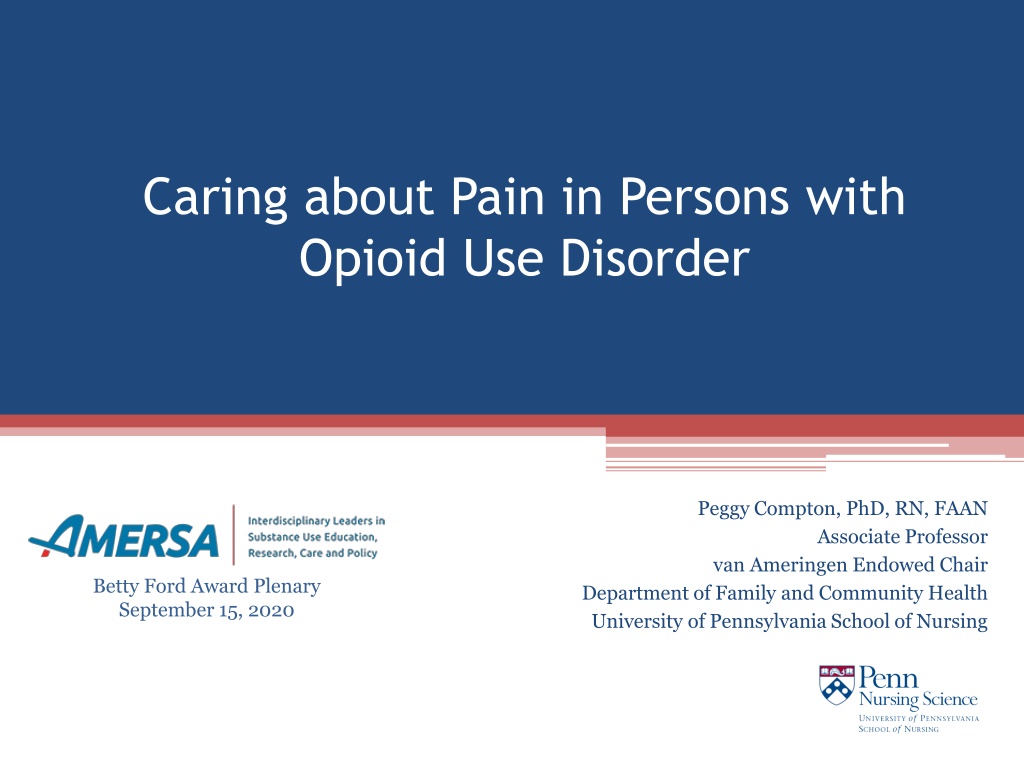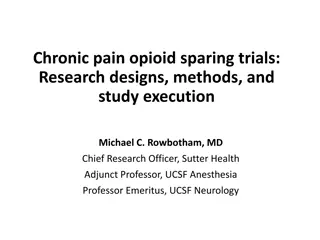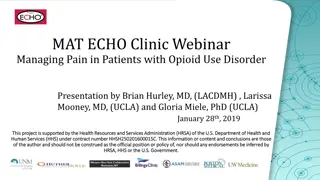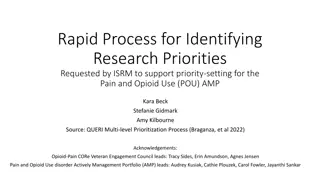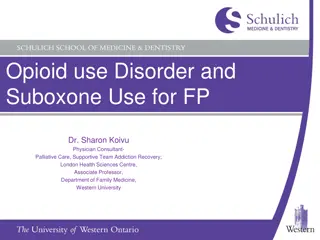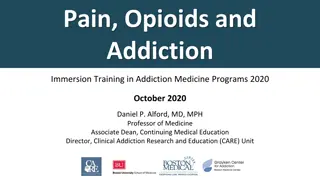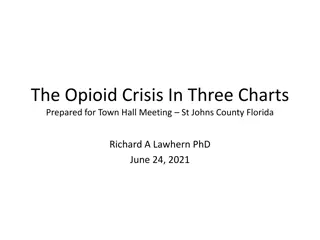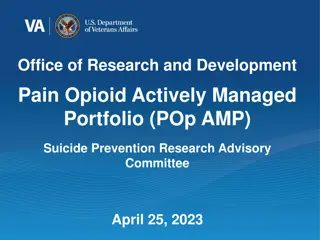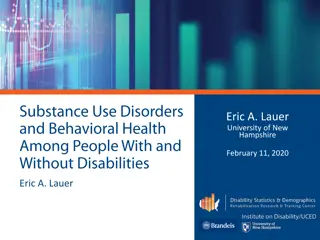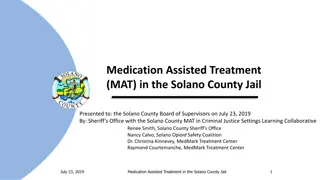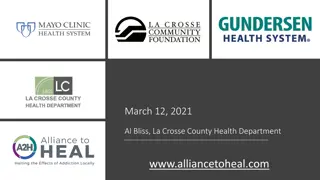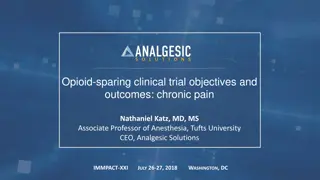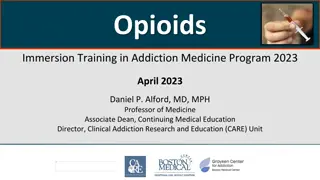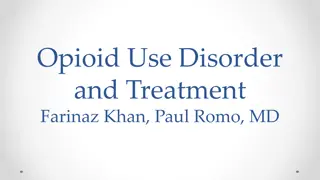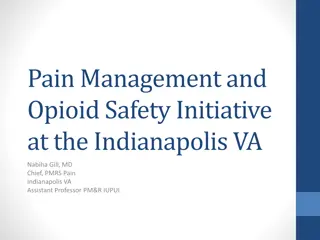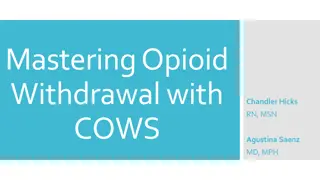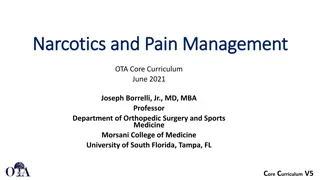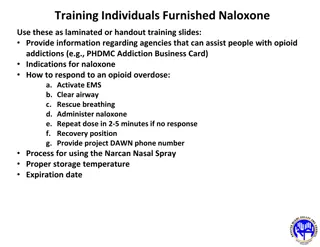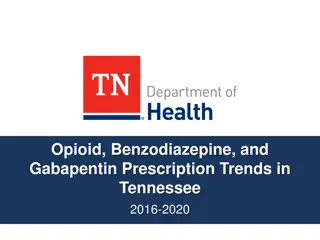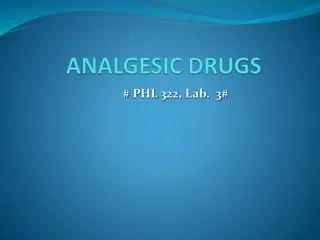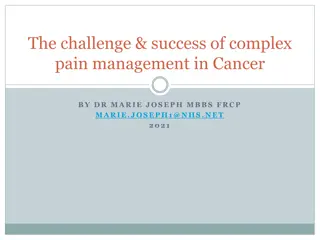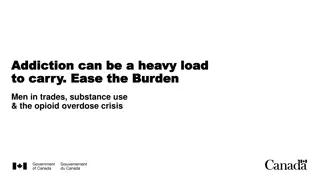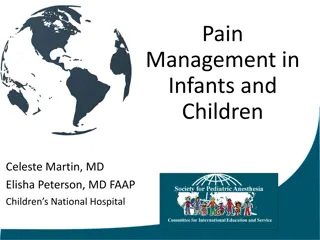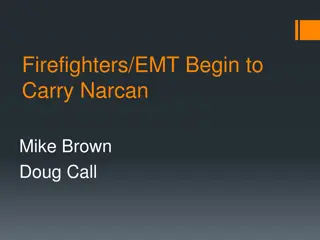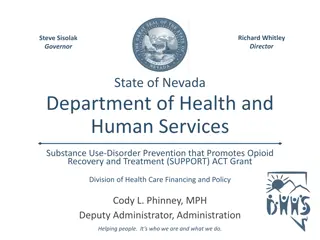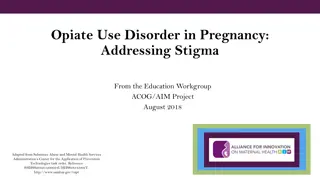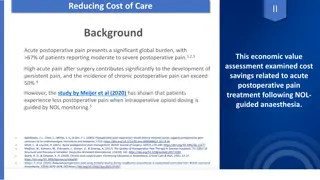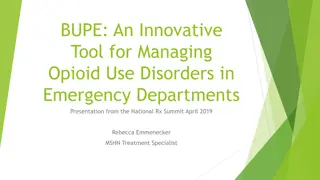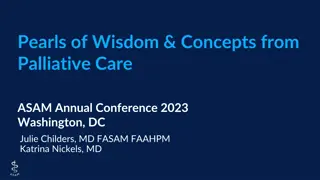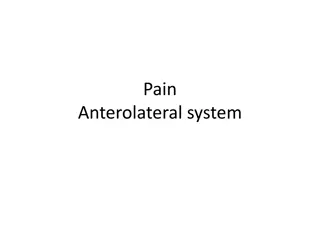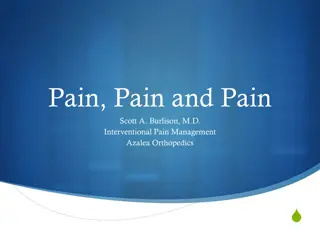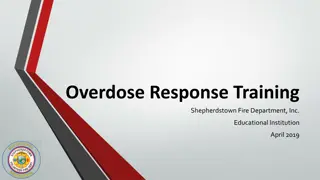Understanding Pain in Opioid Use Disorder
This presentation by Peggy Compton highlights the importance of caring for pain in individuals with opioid use disorder. It delves into the relationship between pleasure and pain, the continuum of human sensation, and the dual role of opioids in pain and reward responses. Compton's research, supported by grants, focuses on optimizing pain management in various healthcare settings.
Download Presentation

Please find below an Image/Link to download the presentation.
The content on the website is provided AS IS for your information and personal use only. It may not be sold, licensed, or shared on other websites without obtaining consent from the author. Download presentation by click this link. If you encounter any issues during the download, it is possible that the publisher has removed the file from their server.
E N D
Presentation Transcript
Caring about Pain in Persons with Opioid Use Disorder Peggy Compton, PhD, RN, FAAN Associate Professor van Ameringen Endowed Chair Department of Family and Community Health University of Pennsylvania School of Nursing Betty Ford Award Plenary September 15, 2020
Acknowledgements Nominators Madeline Naegle, PhD, CNS-PMH,BC, FAAN Carol Boyd, PhD, RN, FIAAN, FAAN AMERSA Awards Committee Collaborators at University of Pennsylvania: Martin Cheatle, PhD, Dept of Psychiatry, Perelman School of Medicine Heath Schmidt, PhD,Dept of Biobehavioral Health Sciences, School of Nursing Elliot Hersh, DMD, MS, PhD, Dept of oral Surgery, School of Dental Medicine Krisda H. Chaiyachati, MD, MPH, MSHP, Dept of Medicine, Perelman School of Medicine Salimah H. Meghani, PhD, MBE, RN, FAAN, Dept of Biobehavioral Health Sciences, School of Nursing Nabil M Elkassabany, MD, Dept Anesthesiology and Critical Care, Hospital of the University of Pennsylvania
Disclosures No conflicts of interest to disclose No sponsorship or commercial support was provided to support the development of this presentation Grant support National Institute on Drug Abuse (NIDA), Effect of Opioid Taper on Pain Responses in Patients with Chronic Pain (PI Compton, R21DA 046364) PACIRA Pharmaceuticals, Improving Patient Outcomes using Multimodal Perioperative Pain Management (Co-PI Compton, IIT#2018-015 )
A Program of Research in Pain & Addiction Where it began ..
For pain is perhaps but a violent pleasure? Who could determine the point where pleasure becomes pain, where pain is still a pleasure? Honor De Balzac (1799 1850) Pleasure and pain, though directly opposite, are yet so contrived by nature as to be constant companions; and it is a fact that the same motions and muscles of the face are employed both laughing and crying. -Pierre Charron (1541 - 1603) PainPleasure A Continuum of Human Sensation
Opioids are active in both Pain and Reward responses Ballantyne and LaForge, 2007 Both analgesic and euphoric effects can be blocked with naloxone
Pain and Addiction As Interrelated Phenomena Addiction responses in pain patients taking opioids Pain responses of patients with opioid use disorder Addiction patient Pain patient w/ w/ Pain Addiction
Pain and Addiction As Interrelated Phenomena Pain responses of opioid-dependent (addicted) patients Addiction patient Addiction responses in opioid-dependent pain patients Pain patient w/ Pain w/ Addiction
Pain Tolerance in current and former Opioid and Cocaine abusers 180 150 120 opioid abusers cocaine abusers 90 ex-opioid abusers 60 ex-cocaine abusers 30 0 cold-pressor pain tolerance (seconds) *Pain tolerance unrelated to dose or time on methadone (R03 HS06964 DHHS, AHCPR, Compton, 1994) (Compton,1994) R03 HS06964 DHHS, AHCPR, PI: Compton
Addiction results in a Syndrome of Pain Facilitation Discomfort augmented by: subtle withdrawal syndromes intoxication or withdrawal-related sympathetic arousal, muscular tension concomitant health problems sleep disturbances affective changes functional changes ((((Schofferman & Savage
Pain Tolerance in current and former Opioid and Cocaine abusers 180 150 120 opioid abusers cocaine abusers 90 ex-opioid abusers 60 ex-cocaine abusers 30 0 cold-pressor pain tolerance (seconds) *Pain tolerance unrelated to dose or time on methadone (R03 HS06964 DHHS, AHCPR, Compton, 1994) (Compton,1994) R03 HS06964 DHHS, AHCPR, PI: Compton
Opioid-induced Hyperalgesia (OIH) Increased sensitivity to pain resulting from opioid administration Pain-free animal models have significantly decreased nociceptive threshold following single or repeated administration of opioids Opioids, in addition to providing analgesia, set in motion anti-analgesic or hyperalgesic processes Opioid-withdrawal hyperalgesia as an unmasking of underlying opioid-induced hyperalgesic state Role in analgesic tolerance?
Genetic propensity to develop Opioid-induced Hyperalgesia Liang DY, et al., Pharmacogenet Genomics. 2006;16(11):825-35.
Opioid-induced Hyperalgesia as an Opponent Process Opioid administration Opioid-induced hyperalgesia SENSITIZATION Pain tolerance Opioid-induced analgesia DESENSITIZATION Adapted from: Solomon R, 1980; Koob GF et al., 1989
Cold-pressor hyperalgesia in pts with opioid use disorder on opioid agonist therapy Cold-pressor withdrawal latency in persons with opioid use disorder on MAT and matched controls, p<0.05 Compton, et al., 2001 Cold-pressor pain tolerance of methadone-maintained and matched control subjects, p<0.02 Compton, et al., 2000 R03 DA09866, NIDA, PI: Compton
Opioid-induced hyperalgesia present at both peak and trough methadone blood levels Doverty et al., Pain, 2001 Opioid-induced hyperalgesia in heroin abusers: No change with OAT Compton et al., J Pain. 2012 4-8wks 12-18wks
Not a new observation At such times I have certainly felt it a great responsibility to say that pain, which I know is an evil, is less injurious than morphia, which may be an evil. Here experience is needed. Does morphia tend to encourage the very pain it pretends to relieve? On the abuse of hypodermic injections of morphia, Clifford Albutt, Practitioner 1870; 3:327-330 . He is also affected by a hypersensitiveness to pain, or a morbid intolerance of any kind of distress . He suffers. His suffering is actually great. To his astigmatic inner eye it seems even greater than it is. What is the morphine disease? Charles W. Carter Journal of Inebriety 1908;30:28-33.
Opioid-induced Hyperalgesia and Post-operative Pain Responses in patients on OAT On stable dose OAT x 3 months No opioid exposure x 3 months Oral surgical procedure with trauma rating of between 5 10 Prescribed NSAIDs for post-operative pain Compare: Pre-operative hyperalgesia (cold-pressor test) 72hr pain severity and medication use (pain diary) Schoenleber Pilot Grant Program, PI Compton
Pain Severity Ratings following Surgery Opioid-induced Hyperalgesia and Post-operative Pain Responses in patients on Opioid Agonist Therapy 8 * 7 6 VAS pain severity 5 4 3 2 1 0 not on opioids on opioids Number of doses of analgesics taken post-operatively no. of doses 0 2 4 6 8 10 on opioids not on opioids
Hyperalgesia persists 28 days following opioid detoxification Pain responses of opioid addicts (OA) and controls across time (means S.D.). Y-axis latency, tolerance, and pain intensity. ***p 0.0001 between controls and OAs. No differences between the three time points in the OAs group. Pud et al., Drug Alcohol Depend. 2006 May 20;82(3):218-23.
So, is the hyperalgesia in pts on OAT opioid-induced? Or are opioid abusers hyperalgesic by nature? Cold pressor pain tolerance (sec) 300 200 100 Pain intolerant Pain tolerant Walsh et al, 1989
Opioid use disorder and hyperalgesia Ex-opioid Addicts X Matched Controls X On Opioids < Martin & Inglis, 1965 X < X = X Hole and Dole, 1979 X < X Carcoba et al., 2011 X < X Compton, 1994 X < X Compton et al, 2001 X < X Pud, 2006 X < X Ren et al., 2009 X < X = X Triester et al., 2012
Opioid use disorder and hyperalgesia Ex-opioid Addicts X Matched Controls X On Opioids < Martin & Inglis, 1965 X < X = X Hole and Dole, 1979 X < X Carcoba et al., 2011 X < X Compton, 1994 X < X Compton et al, 2001 X < X Pud, 2006 X < X Ren et al., 2009 X < X = X Triester et al., 2012
Genetic propensity to develop opioid-induced hyperalgesia C57BL/6J common inbred - Poor baseline pain tolerance - Poor analgesia response - High opioid reinforcement Liang DY, et al., Pharmacogenet Genomics. 2006;16(11):825-35.
Elevated pain sensitivity in chronic pain patients at risk for opioid misuse No Opioids Pain sensitivity - ratings (0 100) for repeated punctuate mechanical stimuli SOAPP - Screener and Opioid Assessment for Patients in Pain Low-Dose Opioids High-Dose Opioids Edwards RR ,et al. The Journal of Pain, 2011 ,
Pain Responses in Chronic Pain patients who did and did not develop OUD Compton et al., 2020 Based on past 12 months chart review and clinician interview: OUD (n=20) Non-OUD (n=20) no previous history of substance use disorder (except nicotine dependence) prior to beginning long- term opioid therapy endorse DSM-5 criteria for OUD on both the MINI International Neuropsychiatric Interview and DSM- 5 checklist actively receiving treatment for an OUD no current or past history of a substance use disorder (except nicotine dependence) no evidence of ADRB all urine drug screens show presence of prescribed opioid & absence of non-prescribed or illicit drug do not endorse DSM-5 criteria for OUD on both the MINI International Neuropsychiatric Interview and DSM- 5 checklist
In Summary.. Pain and opioid use disorder are interrelated phenomena Patients on opioid-agonist therapy have increased sensitivity to pain Whether heightened pain sensitivity is opioid-induced or trait is not clear Complaints of pain from patients with OUD should be taken seriously and managed aggressively
References Compton P, Wasser TE, Cheatle M. (2020). Increased Experimental Pain Sensitivity in Chronic Pain Patients who developed Opioid Use Disorder. Clinical Journal of Pain, 36, 667 674. Compton P. (2019). Acute Pain Management for Patients on Medication-assisted Therapy. AACN Advanced Critical Care, 30(4): 335-342. Arout CA, Waters AJ, MacLean RR, Compton P, Sofuoglu M. (2019). Minocycline does not affect experimental pain or addiction-related outcomes in opioid maintained patients. Psychopharmacology, 236(10):2857-2866 Giron SE, Olson RA, Griffis CA, Compton P. (2018). The Opioid Crisis and the Certified Registered Nurse Anesthetist: Caring for Patients with Opioid Use Disorder in Drug-Free Recovery. AANA Journal 86(5): 82-82. Myers J, Compton P. (2018). Addressing the Potential for Perioperative Relapse in Those Recovering from Opioid Use Disorder. Pain Medicine. 19(10):1908-1915. doi: 10.1093/pm/pnx277. Compton P, Griffis C, Breen EC, Torrington M, Sadakane R, Tefera E, Irwin MR.(2015) Opioid Treatment of Experimental Pain Activates Nuclear Factor-B J Opioid Manag. Mar-Apr;11(2):115-25. *Compton P, Canamar C, Hillhouse M, Ling W. (2012). Hyperalgesia in heroin dependent patients and the effects of opioid substitution therapy. Journal of Pain, 13: 401-409. Compton P, Kehoe P, Sinha K, Torrington MA, Ling W. (2010). Gabapentin improves cold-pressor pain responses in methadone-maintained patients. Drug Alcohol Depend. 109(1-3):213-9. Compton P, Ling W, Torrington MA. (2008). Lack of Effect of Chronic Dextromethorphan on Experimental Pain Tolerance in Methadone-maintained Patients. Addiction Biology 13(3-4):393-402. Compton P. (2008). Should Opioid Abusers Be Discharged From Opioid-Analgesic Therapy, Pain Med 9(4):383-90. Compton P, Miotto K, Elashoff D. (2003). Precipitated Opioid Withdrawal Across Acute Physical Dependence Induction Methods. Pharmacology, Biochemistry, and Behavior, 77: 263-268. Compton P, Athanasos P, Elashoff D. (2003). Withdrawal Hyperalgesia After Acute Opioid Physical Dependence in Nonaddicted Humans: A Preliminary Study. The Journal of Pain, 4(9): 511-519. Compton P, Charuvastra VC, Ling (2001). Pain Intolerance in Opioid-Maintained Former Opiate Addicts: Effect of Long- Acting Maintenance Agent. Drug Alcohol Depend., 63:139-146. Compton P, Charuvastra VC, Kintaudi K, Ling W. (2000). Pain Responses in Methadone-Maintained Opioid Abusers Journal of Pain and Symptom Management, 20(4):237-245. Compton P. (1994). Cold Pressor Pain Tolerance in Opiate and Cocaine Abusers: Correlates of Drug Type and Use Status. J Pain Symptom Manage, 9:462-473.
Thank you! Peggy Compton, PhD, RN, FAAN Associate Professor van Ameringen Endowed Chair Department of Family and Community Health University of Pennsylvania School of Nursing pcompton@nursing.upenn.edu
